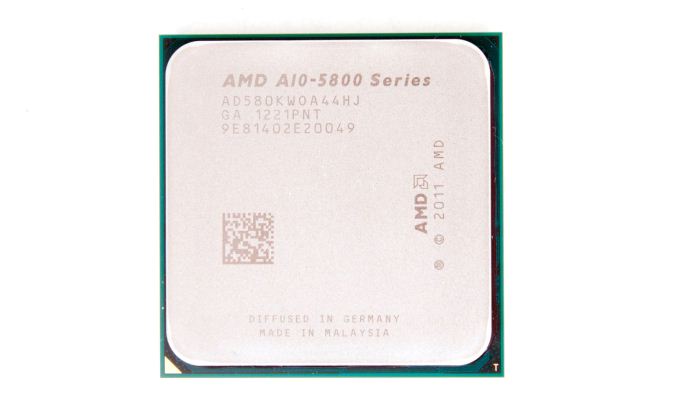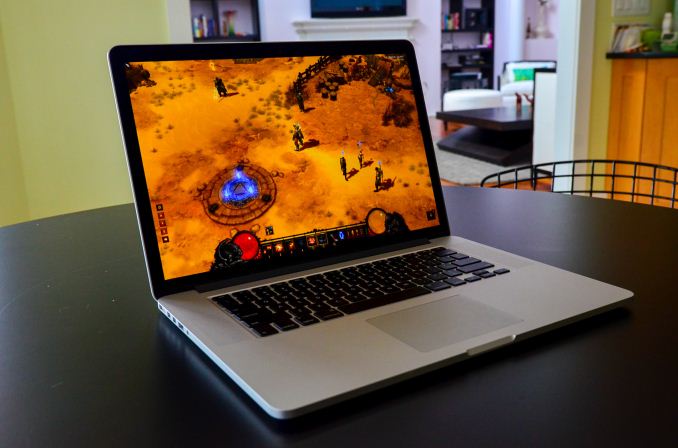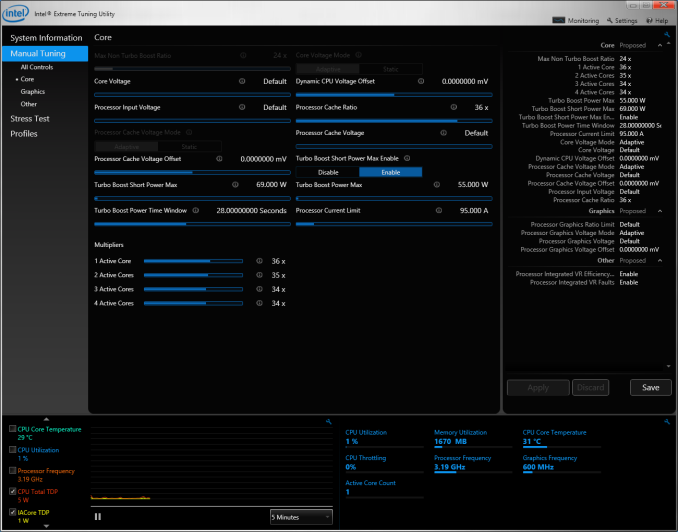Intel Iris Pro 5200 Graphics Review: Core i7-4950HQ Tested
by Anand Lal Shimpi on June 1, 2013 10:01 AM ESTThe Comparison Points
Intel sort of dropped this CRB off without anything to compare it to, so I scrambled over the past week looking for things to put Iris Pro’s performance in perspective. The obvious candidate was Apple’s 15-inch MacBook Pro with Retina Display. I expect its successor will use Iris Pro 5200, making this a perfect comparison point. The 15-inch rMBP is equipped with a GeForce GT 650M with a 900MHz core clock and a 5GHz memory datarate.
I also dusted off a GeForce GT 640 desktop card to shed a little more light on the 650M comparison. The 640 has a slightly higher core clock (925MHz) but it only has 1.7GHz DDR3, working out to be 27GB/s of memory bandwidth compared to 83GB/s for the 650M. Seeing how Iris Pro compares to the GT 640 and 650M will tell us just how good of a job Crystalwell is doing.
Next up is the desktop Core i7-4770K with HD 4600 graphics. This is a Haswell GT2 implementation, but at a much higher TDP than the 47W mobile part we’re comparing it to (84W). In a notebook you can expect a much bigger gap in performance between the HD 4600 and Iris Pro than what we’re showing here. Similarly I also included a 77W HD 4000 for a comparison to Ivy Bridge graphics.
On the AMD front I have the 35W A10-4600M (codename Trinity), featuring AMD’s 7660G processor graphics. I also included the 100W A10-5800 as a reference point since we were largely pleased with the GPU performance of Trinity on the desktop.
I listed TDPs with all of the parts I’m comparing here. In the case of the GT 640 I’m adding the TDP of the CPU (84W) and the GPU (65W). TDP is half of the story with Iris Pro, because the CPU, GPU and eDRAM all fit into the same 47W power envelope. With a discrete GPU, like the 650M, you end up with an extra 45W on top of the CPU’s TDP. In reality the host CPU won’t be running at anywhere near its 45W max in that case, so the power savings are likely not as great as you’d expect but they’ll still be present.
At the request of at least one very eager OEM, Intel is offering a higher-TDP configuration of the i7-4950HQ. Using Intel’s Extreme Tuning Utility (XTU) I was able to simulate this cTDP up configuration by increasing the sustained power limit to 55W, and moving the short term turbo power limit up to 69W. OEMs moving from a 2-chip CPU + GPU solution down to a single Iris Pro are encouraged to do the same as their existing thermal solutions should be more than adequate to cool a 55W part. I strongly suspect this is the configuration we’ll see in the next-generation 15-inch MacBook Pro with Retina Display.
To remove as many bottlenecks as possible I configured all integrated GPU options (other than Iris Pro 5200) with the fastest supported memory. That worked out to being DDR3-2133 on desktop Trinity and desktop IVB, and DDR3-2400 on desktop Haswell (HD 4600). The mobile platforms, including Iris Pro 5200, all used DDR3-1600.
On the software side I used NVIDIA's GeForce R320 v320.18, AMD's Catalyst 13.6 beta and Intel's 9.18.10.3177 drivers with Crystalwell support.













177 Comments
View All Comments
HisDivineOrder - Saturday, June 1, 2013 - link
I see Razer making an Edge tablet with an Iris-based chip. In fact, it seems built for that idea more than anything else. That or a NUC HTPC run at 720p with no AA ever. You've got superior performance to any console out there right now and it's in a size smaller than an AppleTV.So yeah, the next Razer Edge should include this as an optional way to lower the cost of the whole system. I also think the next Surface Pro should use this. So high end x86-based laptops with Windows 8 Pro.
And NUC/BRIX systems that are so small they don't have room for discrete GPU's.
I imagine some thinner than makes sense ultrathins could also use this to great effect.
All that said, most systems people will be able to afford and use on a regular basis won't be using this chip. I think that's sad, but it's the way it will be until Intel stops trying to use Iris as a bonus for the high end users instead of trying to put discrete GPU's out of business by putting these on every chip they make so people start seeing it CAN do a decent job on its own within its specific limitations.
Right now, no one's going to see that, except those few fringe cases. Strictly speaking, while it might not have matched the 650m (or its successor), it did a decent job with the 640m and that's a lot better than any other IGP by Intel.
Spunjji - Tuesday, June 4, 2013 - link
You confused me here on these points:1) The NUC uses a 17W TDP chip and overheats. We're not going to have Iris in that form factor yet.
2) It would increase the cost of the Edge, not lower it. Same TDP problem too.
Otherwise I agree, this really needs to roll down lower in the food chain to have a serious impact. Hopefully they'll do that with Broadwell used by the GPU when the die area effectively becomes free thanks to the process switch.
whyso - Saturday, June 1, 2013 - link
So intel was right. Iris Pro pretty much matches a 650m at playable settings (30 fps +). Note that anandtech is being full of BullS**t here and comparing it to an OVERCLOCKED 650m from apple. Lets see, when intel made that 'equal to a 650m' claim it was talking about a standard 650m not an overclocked 650m running at 900/2500 (GDDR5) vs the normal 835/1000 (GDDR5 + boost at full, no boost = 735 mhz core). If you look at a standard clocked GDDR3 variant iris pro 5200 and the 650m are pretty much very similar (depending on the games) within around 10%. New Intel drivers should further shorten the gap (given that intel is quite good in compute).JarredWalton - Sunday, June 2, 2013 - link
http://www.anandtech.com/bench/Product/814For the games I tested, the rMBP15 isnt' that much faster in many titles. Iris isn't quite able to match GT 650M, but it's pretty close all things considered.
Spunjji - Tuesday, June 4, 2013 - link
I will believe this about new Intel drivers when I see them. I seriously, genuinely hope they surprise me, though.dbcoopernz - Saturday, June 1, 2013 - link
Are you going to test this system with madVR?Ryan Smith - Sunday, June 2, 2013 - link
We have Ganesh working to answer that question right now.dbcoopernz - Sunday, June 2, 2013 - link
Cool. :)JDG1980 - Saturday, June 1, 2013 - link
I would have liked to see some madVR tests. It seems to me that the particular architecture of this chip - lots of computing power, somewhat less memory bandwidth - would be very well suited to madVR's better processing options. It's been established that difficult features like Jinc scaling (the best quality) are limited by shader performance, not bandwidth.The price is far steeper than I would have expected, but once it inevitably drops a bit, I could see mini-ITX boards with this become a viable solution for high-end, passively-cooled HTPCs.
By the way, did they ever fix the 23.976 fps error that has been there since Clarkdale?
dbcoopernz - Saturday, June 1, 2013 - link
Missing Remote reports that 23.976 timing is much better.http://www.missingremote.com/review/intel-core-i7-...